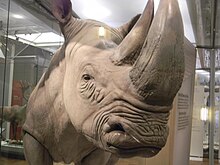
The San Diego Zoo Safari Park, originally named the San Diego Wild Animal Park until 2010, is an 1800-acre zoo in the San Pasqual Valley area of San Diego, California, near Escondido. It is one of the largest tourist attractions in San Diego County. The park houses a large array of wild and endangered animals from every continent, except Antarctica; this includes the largest, most comprehensive collection of hoofed mammals (ungulates) in the world. The park is in a semi-arid environment, about 30 miles (48 km) inland from the Pacific Ocean, giving it a year-round ‘feeling’ of being in Africa, with one of its most notable attractions being the Africa Tram, a half-hour guided tram ride which showcases the expansive ‘grassland’ exhibits. These free-range enclosures house the majority of the park's larger species, such as numerous antelopes, giraffes, buffalo, cranes, and rhinoceros, among others. The park is also noted for its California condor breeding program. When booked in-advance, the park also offers several longer, more in-depth safari options, some of which involve riding in an open-top truck to feed the animals in the field enclosures.

The Javan rhinoceros, Javan rhino, Sunda rhinoceros or lesser one-horned rhinoceros is a critically endangered member of the genus Rhinoceros, of the rhinoceros family, Rhinocerotidae, and one of the five remaining extant rhinoceros species across South Asia and Africa. The Javan rhinoceros is one of the smallest rhinoceros species, along with the Sumatran, or "hairy", rhinoceros. They are superficially similar to Indian rhinos, as they have plate-like, "armored" protective skin folds, but are slightly smaller in size, at just 3.1–3.2 m (10–10 ft) long and 1.4–1.7 m (4.6–5.6 ft) tall, on average. The heaviest specimens weigh around 2,300 kg/2.3 tonnes, similar to a black rhinoceros. However, unlike the long and potentially lethal horns of the black or white rhinoceroses of Africa, the Javan species' single, somewhat blunted horn is usually shorter than 25 cm (9.8 in).

The Royal Ontario Museum (ROM) is a museum of art, world culture and natural history in Toronto, Ontario, Canada. It is one of the largest museums in North America and the largest in Canada. It attracts more than one million visitors every year, making it the most-visited museum in Canada. It is north of Queen's Park, in the University of Toronto district, with its main entrance on Bloor Street West. Museum subway station is named after it and, since a 2008 renovation, is decorated to resemble the ROM's collection at the platform level.

Whipsnade Zoo, formerly known as ZSL Whipsnade Zoo and Whipsnade Wild Animal Park, is a zoo and safari park located at Whipsnade, near Dunstable in Bedfordshire, England. It is one of two zoos that are owned by the Zoological Society of London (ZSL), a charity devoted to the worldwide conservation of animals and their habitats.
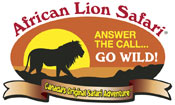
African Lion Safari is a family-owned safari park in Southern Ontario, Canada, located between the cities of Hamilton and Cambridge, located 100 kilometres (62 mi) west of Toronto. Guests may tour seven game reserves, with a total area of about 740 acres, on tour buses or in visitors' own vehicles, where animals roam freely in contained areas. Accompanying the game reserves is a walking section where exotic birds and primates, as well as the park's herd of Asian elephants, are on display.
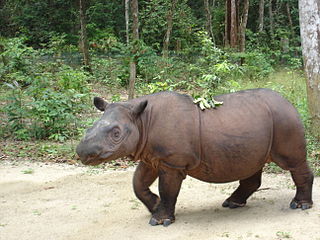
The Sumatran rhinoceros, also known as the Sumatran rhino, hairy rhinoceros or Asian two-horned rhinoceros, is a rare member of the family Rhinocerotidae and one of five extant species of rhinoceros; it is the only extant species of the genus Dicerorhinus. It is the smallest rhinoceros, although it is still a large mammal; it stands 112–145 cm (44–57 in) high at the shoulder, with a head-and-body length of 2.36–3.18 m and a tail of 35–70 cm (14–28 in). The weight is reported to range from 500–1,000 kg (1,100–2,200 lb), averaging 700–800 kg (1,540–1,760 lb). Like both African species, it has two horns; the larger is the nasal horn, typically 15–25 cm (5.9–9.8 in), while the other horn is typically a stub. A coat of reddish-brown hair covers most of the Sumatran rhino's body.

The Indian rhinoceros, also known as the greater one-horned rhinoceros, great Indian rhinoceros, or Indian rhino for short, is a rhinoceros species native to the Indian subcontinent. It is the second largest extant species of rhinoceros, with adult males weighing 2.07–2.2 tonnes and adult females 1.6 tonnes. The skin is thick and is grey-brown in colour with pinkish skin folds. They have a single horn on their snout that grows to a maximum of 57.2 cm (22.5 in). Their upper legs and shoulders are covered in wart-like bumps. They are nearly hairless, aside from the eyelashes, ear fringes and tail brush.
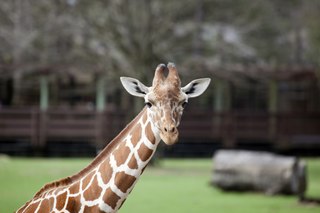
Montgomery Zoo is a 40-acre (16 ha) zoo located on the north side of Montgomery, Alabama. The zoo is an independent city department, and is supported in part by The Montgomery Area Zoolocal Society. It is home to approximately 750 animals representing 140 species. After not renewing their Association of Zoos and Aquariums membership in 2013, the zoo opted to remain accredited solely by the Zoological Association of America. The Mann Wildlife Learning Museum opened in January 2003 and serves as the administration building. The museum features taxidermy displays with a focus on native wildlife, game species, and wildlife management.

Dublin Zoo, in Phoenix Park, is a zoo in Dublin, Ireland, and one of Dublin's most popular attractions. Established and designed in 1830 by Decimus Burton, it opened the following year. Today it focuses on conservation projects, breeding programmes, and growing awareness for animals. Its stated mission is to "work in partnership with zoos worldwide to make a significant contribution to the conservation of the endangered species on Earth".

The white rhinoceros, white rhino or square-lipped rhinoceros is the largest extant species of rhinoceros. It has a wide mouth used for grazing and is the most social of all rhino species. The white rhinoceros consists of two subspecies: the southern white rhinoceros, with an estimated 16,803 wild-living animals, and the much rarer northern white rhinoceros. The northern subspecies has very few remaining individuals, with only two confirmed left in 2018. Sudan, the world's last known male northern white rhinoceros, died in Kenya on 19 March 2018 at age 45.
Port Lympne Hotel & Reserve near the town of Hythe in Kent, England is set in 600 acres (2.4 km2) and incorporates the historic Port Lympne Mansion, and landscaped gardens designed by architect Sir Herbert Baker, for Sir Philip Sassoon.

The Birmingham Zoo is a zoological park that opened in 1955 in Birmingham, Alabama, United States.

Auckland Zoo is a 16.35-hectare (40-acre) zoological garden in Auckland, New Zealand, situated next to Western Springs Park not far from Auckland's central business district. It is run by Auckland Council with the Zoological Society of Auckland as a supporting organisation.

The Zoological Center Tel Aviv-Ramat Gan in the Tel Aviv District city of Ramat Gan, Israel, is the largest collection of wildlife in human care in the Middle East. The 250-acre site consists of both a drive-through African safari area and a modern outdoor zoo. The African animal park opened to the general public in 1974. In 1981, the zoo was established in the middle of the park to replace the Tel Aviv Zoo, which had closed down.

The northern white rhinoceros or northern white rhino is one of two subspecies of the white rhinoceros. This subspecies is a grazer in grasslands and savanna woodlands. Formerly found in several countries in East and Central Africa south of the Sahara, since 19 March 2018, there are only two known rhinos of this subspecies left, named Najin and Fatu, both of which are female; barring the existence of unknown or misclassified male northern white rhinos elsewhere in Africa, this makes the subspecies functionally extinct. The two female rhinos belong to the Dvůr Králové Zoo in the Czech Republic but live in the Ol Pejeta Conservancy in Kenya where they are protected by armed guards.

Niabi Zoo is a public Zoological Park in Coal Valley, Illinois, serving the Quad Cities Area. This 40 acre zoo is nestled inside its 287 acre forest preserve. The exploration of this picturesque setting guides guests through the discovery of more than 600 animals representing nearly 200 animal species from around the world. Niabi Zoo is open for general admission April–October annually and offers robust education and outreach programs year round.

Zoo Basel is a non-profit zoo in the city of Basel, Switzerland. Its official name is Zoologischer Garten Basel — or in English: Basel Zoological Garden. Basel residents affectionately call it Zolli. Its main entrance is just outside Basel's downtown strip of Steinen-Vorstadt and extends in the Birsig stream valley to Basel's city border with Binningen, Basel-Country.

Angalifu was a captive northern white rhinoceros held at the San Diego Zoo Safari Park. At the time of his death, he was one of six living northern white rhinoceroses in the world, one of two living males in the world, and the only male on the American continents. He was outlived by male Sudan and females Najin and Fatu.
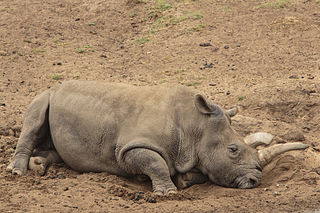
Nola was a northern white rhinoceros who lived at the San Diego Zoo Safari Park near Escondido, California. At her death, she was one of only four of her subspecies overall. She was outlived by male Sudan and females Najin and Fatu.
Thomas Earl Benner was a Canadian sculptor of large sculptures, a painter and an installation artist who explored such themes as the environment, history and nature. His work was widely exhibited in Canada and the United States in public galleries and even in unconventional places, such as Union Station in Toronto. He is associated with a movement in Canadian art known as London Regionalism, which took place in the city of London, Ontario, where he was born and lived.
